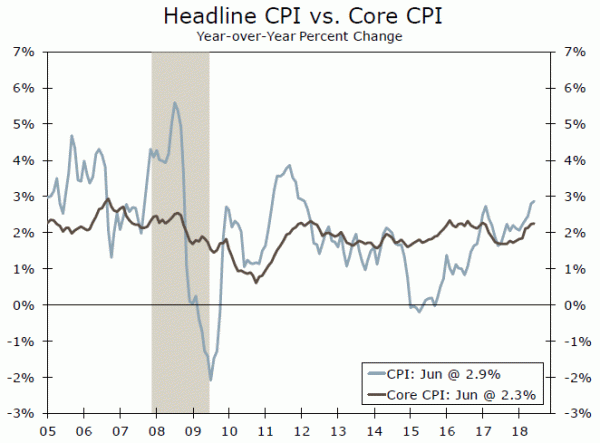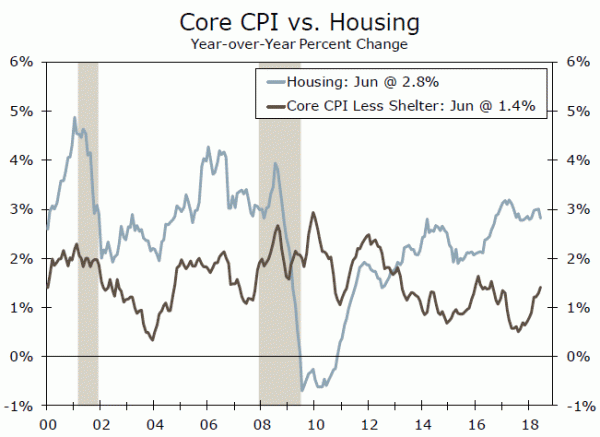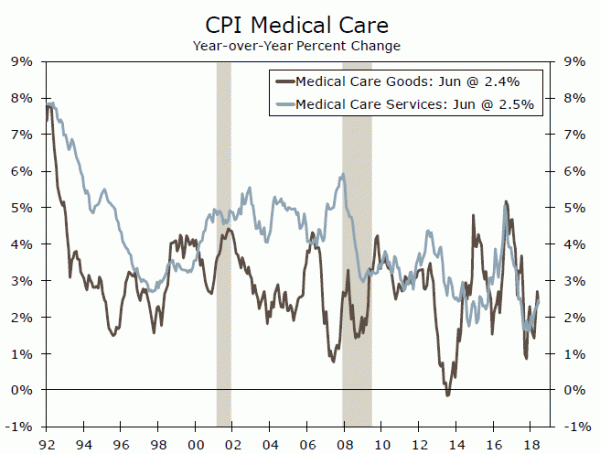CPI rose 0.1 percent in June and is up 2.9 percent over the past year. While the lift to the year-ago rate from energy is expected to ease, inflation pressures continue to build and should keep the core at the Fed’s target.
Moderate Gains in Headline and Core CPI in June
Consumer price inflation came in a touch lower than expected in June, with the headline index rising 0.1 percent. Nevertheless, the CPI is up 2.9 percent over the past year, which is the strongest pace in more than six years.
The multi-year high in the pace of headline inflation can be traced to the sizeable jump in fuel prices over the past year. Energy goods, which make up about 5 percent of the index, are up 24 percent from a year ago. Gasoline prices rose at a more modest rate in June, though, while declining costs for electricity and utility gasoline the past few months suggest energy’s lift to the headline pace of inflation should ease in the coming months.
As we expected, the rise in the core index came in at a “low” 0.2 percent (0.16 before rounding). Core services inflation eased slightly, up 0.2 percent in June versus 0.3 percent in May. The smaller gain stemmed in large part from a sharp drop in lodging away from home, which reversed a three-month run of solid gains by falling 3.7 percent in June. Shelter costs for primary housing, however, continue to rise steadily and propel the core index higher. Excluding shelter, core CPI has still moved up over the past year and is back near the pace that prevailed in 2016. Further gains in medical care, including a 0.4 percent increase in June, have been a key contributor, while deflation among core goods continues to ease.
Back at the Fed’s Target and Likely to Stay
While headline inflation has been boosted by the sharp rise in oil prices over the past year, the core has signaled that the underlying trend inflation has firmed. In May, the core PCE deflator hit 2.0 percent year-over-year for the first time since 2012, and, at 2.3 percent, the core CPI corroborates that inflation is running at the Fed’s target.
Further improvement in the 12-month pace of the core index is expected to slow in the second half of the year since base comparisons are getting tougher now that the slowdown of last spring/early summer is a full year behind us. In addition, the recent pace of monthly gains has slowed from earlier this year, when lingering seasonality likely overstated the upward trend. The three-month annualized pace has eased to 1.7 percent after increasing just shy of 3 percent in March.
We expect to see core CPI, when measured on a 12-month basis, to remain near its current rate through the second half of the year before strengthening more in 2019. Solid consumer spending and minimal slack in the economy point to price pressures intensifying even though we do not anticipate much movement in the year-ago rate of core CPI over the next few months. Broadening tariffs, including the possibility of consumer goods getting hit directly, create some upside risk to our inflation forecast in the second half of the year, however.














